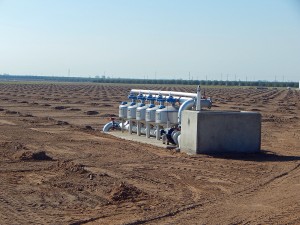
Mel Machado,
Director, Member Relations
This is the final report of the 2015 crop year, covering the conditions and observations made between Monday, October 5, and Sunday, November 1, 2015. The next report will be posted on or about Monday, February 1, 2016 prior to the start of the 2016 bloom.
Northern Region
Sacramento Valley growers enjoyed comfortable temperatures during October, with dry conditions dominating the first weeks of the month. Daily maximum temperatures were reported at their highest levels in the first half of the period, with readings rising daily from the lower 80’s to the lower 90’s. However, readings during the second half of the period dipped into the lower 70’s to lower 80’s, with the arrival of brief, light showers that dropped trace amounts to a few hundredths of an inch of rain over the region at mid-month. While morning minimum temperatures followed a similar pattern, readings exhibited a bit more stability, varying predominately between the mid 50’s to lower 60’s.
Harvest operations in the Sacramento Valley were completed in the latter half of October. While all in the region are looking forward to a wet winter season, growers enjoyed the lack of significant rainfall over the past few months, enabling a clean and relatively uncomplicated harvest. Growers in the northern region also enjoyed the best production of the 2015 crop. Many reported yields greater than recorded in the 2014 crop, with best production rivaling yields reported in 2013. However, quality levels were reported at less than ideal levels, the result of damage caused by Navel Orange Worm, which impacted varieties with open or weak shell seals, allowing worms to enter the kernels.
Post harvest tasks now dominate grower’s schedules. Pruning, brush shredding, fertilizer and soil amendment applications will be prime activities for the next few weeks, with herbicide applications waiting until the first winter rains. Orchard sanitation, the removal and destruction of mummy nuts from the trees will also take place after the first storms weaken the nuts attachment to the trees.
Huller/sheller operators are working to complete processing the last of the previously harvested crop. Meanwhile, growers with older, low producing plantings are removing orchards while those establishing new orchards are preparing the fields for planting later this winter, continuing the cycle of production.
Central Region
Mild conditions dominated the weather in the central region during October, with readings in the period’s opening days widely reported in the low to mid 80’s. Temperatures reached their highest values at mid-month, rising into the lower 90’s before settling back into the mid 70’s as scattered showers passed over the region. Showers returned to the area during the period’s final week, with rainfall totals for the period ranging from trace amounts to 0.2 inch along the east side of the valley. Morning minimum temperatures exhibited a bit more stability than the highs, ranging between the mid 50’s and lower 60’s throughout the region.

A future almond orchard prepared for planting with the irrigation system installed and operational. In this particular case, the water is drawn from a local irrigation district through the concrete structure on the right, pressurized, filtered and distributed to the trees.
Field harvest operations have been completed in the central region and growers have now become fully involved in post-harvest tasks. Operations in the field were completed with little difficulty this year, due to the lack of significant rainfall during the harvest, although the small amount of rainfall received did cause some loads to be dried upon arrival.
Water deliveries from the Oakdale, South San Joaquin, Modesto and Turlock Irrigation Districts also ended during the month, signaling the completion of the 2015 irrigation season. However, the relatively warm temperatures the region has experienced means that the trees are still using water daily, although at a much reduced rate. Growers with water available from private wells are continuing to irrigate as needed to meet the needs of their orchards. This is particularly the case in plantings using micro-sprinkler or drip irrigation, which apply the smallest quantities of water and therefore require continued irrigation to avoid excessive stress.
Many growers have begun pruning their orchards and a few have already completed shredding the resulting brush. Applications of potassium fertilizers and soil amendments aimed at correcting soil pH and salinity levels are occurring throughout the region as growers work to correct problems that have developed during the year. Applications of herbicides to control weed growth within the tree rows have been delayed until the first rainfall of the winter season. All on the region are looking forward to significant rainfall this winter, hoping to replenish soil moisture levels and depleted reservoirs. Further, removal of nuts that failed to drop from the trees during the harvest must wait until the rainy season, as moisture is needed to loosen the nuts, allowing easy removal. Sanitizing the orchards by removing these nuts from the trees and destroying them on the orchard floor is the best method of controlling Navel Orange Worm. Unfortunately, the drought conditions over the past years have made orchard sanitation difficult, which has promoted increasing populations of this serious pest and a corresponding increase in damage to the crop.
While many of the region’s orchards made it through the growing season in good condition, a significant proportion of the region’s plantings are exhibiting signs of stress produced by the lack of water and excessive salinity. Hopefully, ample winter rain will help to correct adverse conditions within the orchards and replenish the region’s water supply.
Southern Region
Variable conditions reigned over the southern region during October, creating a few problems for growers bringing in the later harvesting varieties. Daily maximum temperatures reached their highest values early in the period, rising from the lower 80’s to peak in the low to mid 90’s between the 10th and 19th. Readings then dropped into the lower 70’s with the arrival of a wetter pattern that delivered 0.1 to 0.3 inch of rain at mid-month. Drier conditions prevailed in the closing days of the period as temperatures once again rose in the low to mid 80’s. Morning low temperatures followed a similar pattern as the high’s, ranging from the lower 50’s to low to mid 60’s.
Following a minor delay caused by the rain at mid-month, growers in the southern region have completed the 2015 harvest. Those with crop caught on the ground during the rain were able to dry in the nuts in the field with little difficulty. However, some loads did require further drying upon arrival. While crop is no longer being delivered from the orchards, huller/sheller operations continue to process stockpiled product. Most are anticipating that they will complete operations for the year by the end of November.
Growers in the region have now moved on to a post-harvest mindset, performing a “post-mortem” on the year, reviewing yields and quality levels. Yield levels for most growers increased as the harvest progressed. However, production of the 2015 crop failed to achieve the same level experienced in 2014. Reject levels caused primarily by Navel Orange Worm were also higher than experienced in recent crops.
Looking ahead, pruning, shredding and fertilization are currently among grower’s prime activities. And nearly all in the region are applying some form of soil amendment intended to increase water penetration and promote the leaching of salts that have accumulated during the growing season. Growers continue to condition and service their privately owned wells, working to ensure the availability of water for their orchards. Growers in Madera County and areas of Merced County have endured particular difficulties, and their orchards are showing the greatest degree of water stress. At the same time, orchards along the west side of the region are showing the greatest stress of from excessive salts. All in the region are hopeful that the predictions of a strong El Nino will come true, providing ample water needed for the 2016 crop.
![North2 11-2-15[1]](http://www.bdingredients.com/wp-content/uploads/2015/11/North2-11-2-151-300x225.jpg)
